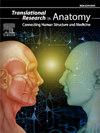肱骨远端窝的解剖学和临床观点:南印度干骨的研究
Q3 Medicine
引用次数: 0
摘要
背景:肱骨远端有三个窝——桡骨窝、冠骨窝和鹰嘴窝,它们在肘部运动时容纳前臂骨突。它们形态和形态的变化会影响关节生物力学、骨折固定和假体设计。然而,关于南印度干肱骨所有三个窝的综合数据仍然有限。本研究旨在通过提供临床相关的形态学见解来填补这一空白。方法对120例年龄、性别不详的成人干肱骨(左、右各60例)进行分析。使用ImageJ软件对标准化照片进行评估。测量了16个参数,包括每个窝的长度、宽度和周长。数据分析采用描述性统计、Pearson相关和t检验。结果左肱骨明显长于右肱骨(平均差1.96 cm),远端宽度明显大于右肱骨(平均差0.58 cm)。冠状窝较长(平均差0.13 cm),右侧周长较大(平均差0.23 cm),左侧桡骨窝和鹰嘴窝较大。形态学分析鉴定出5种鹰嘴窝类型,椭圆形最为常见(44%)。冠状窝和桡骨窝主要呈三角形。肱骨长度或宽度与窝围无显著相关性。滑车上孔,在28.3%的骨骼中发现解剖变异。结论这些发现对骨科手术,如髓内固定、肘关节重建假体设计和法医人类学具有重要意义。本文章由计算机程序翻译,如有差异,请以英文原文为准。
Anatomical and clinical perspectives on the distal humeral fossae: A study in South Indian dry bones
Background
The distal end of the humerus features three fossae—radial, coronoid, and olecranon—that accommodate the processes of the forearm bones during elbow movements. Variations in their morphology and morphometry can influence joint biomechanics, fracture fixation, and prosthesis design. However, comprehensive data on all three fossae in South Indian dry humeri remain limited. This study aims to fill this gap by providing clinically relevant morphometric insights.
Methodology
A total of 120 adult dry humeri (60 right, 60 left) of unknown age and sex were analyzed. Standardized photographs were evaluated using ImageJ software. Sixteen parameters—including the length, width, and circumference of each fossa—were measured. Data were analyzed using descriptive statistics, Pearson's correlation, and t-tests.
Results
The left humerus was significantly longer (mean difference 1.96 cm) and had a greater distal width (mean difference 0.58 cm) than the right. The coronoid fossa was longer (mean difference 0.13 cm) and had a greater circumference on the right (mean difference 0.23 cm), while the radial and olecranon fossae were larger on left. Morphological analysis identified five olecranon fossa types, with oval being most common (44 %). The coronoid and radial fossae were predominantly triangular. No significant correlation was observed between humeral length or width and fossa circumference. The supratrochlear foramen, an anatomical variation which was found in 28.3 % of bones.
Conclusion
These findings have important implications for orthopedic surgery, such as intramedullary fixations, prosthetic design for elbow reconstruction, and forensic anthropology.
求助全文
通过发布文献求助,成功后即可免费获取论文全文。
去求助
来源期刊

Translational Research in Anatomy
Medicine-Anatomy
CiteScore
2.90
自引率
0.00%
发文量
71
审稿时长
25 days
期刊介绍:
Translational Research in Anatomy is an international peer-reviewed and open access journal that publishes high-quality original papers. Focusing on translational research, the journal aims to disseminate the knowledge that is gained in the basic science of anatomy and to apply it to the diagnosis and treatment of human pathology in order to improve individual patient well-being. Topics published in Translational Research in Anatomy include anatomy in all of its aspects, especially those that have application to other scientific disciplines including the health sciences: • gross anatomy • neuroanatomy • histology • immunohistochemistry • comparative anatomy • embryology • molecular biology • microscopic anatomy • forensics • imaging/radiology • medical education Priority will be given to studies that clearly articulate their relevance to the broader aspects of anatomy and how they can impact patient care.Strengthening the ties between morphological research and medicine will foster collaboration between anatomists and physicians. Therefore, Translational Research in Anatomy will serve as a platform for communication and understanding between the disciplines of anatomy and medicine and will aid in the dissemination of anatomical research. The journal accepts the following article types: 1. Review articles 2. Original research papers 3. New state-of-the-art methods of research in the field of anatomy including imaging, dissection methods, medical devices and quantitation 4. Education papers (teaching technologies/methods in medical education in anatomy) 5. Commentaries 6. Letters to the Editor 7. Selected conference papers 8. Case Reports
 求助内容:
求助内容: 应助结果提醒方式:
应助结果提醒方式:


